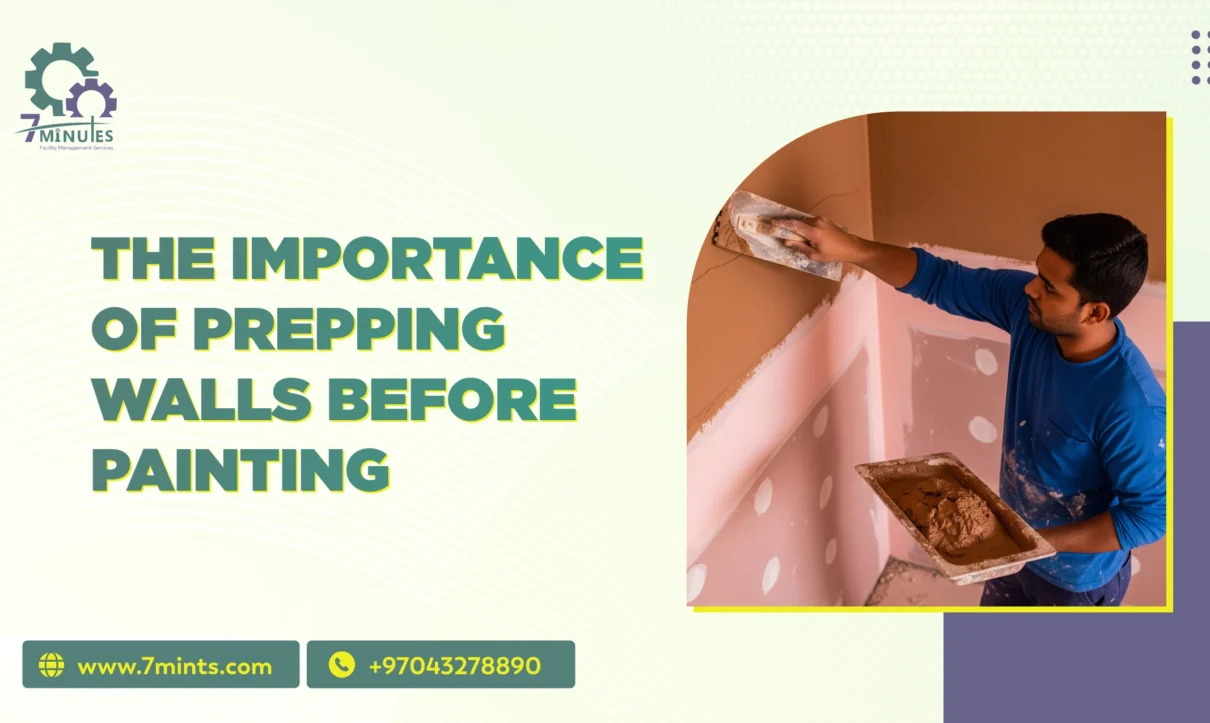One of the most potent ways to energize and transform space is painting. The paint color and finish have great effects when someone is merely repainting a wall or renovating an entire house. But people very often neglect the very important step of preparing the walls. Preparing walls before painting may seem like an extra task, but it is something that ensures a smoothly applied finish to stand the test of time and wear well. It is in this blog where we will speak about the importance of wall preparation, the steps involved, and how each step affects the finishing results of your painting project.
-
Provides a Smooth Surface for Paint Adhesion
Walls carry with them a thin film of dust accumulation, grease, dirt contaminants, etc., with time. The next step is sanding, cleaning, and filling the wall surface so as to ensure a clean base that allows the paint to bond properly. When the surface is smooth and free of any debris, it is easier for the paint to glide on and form a more uniform coat.
-
Helps in Identifying and Fixing Wall Disinfections
Without preparation, unresolved defects would mar the newly done paint job and would become even harder to fix after painting. In the preparation stage, one gets to do a close examination of the surface and repair any defects. Filling of holes with spackle or filler, caulking of gaps, and sanding of uneven patches creates a smooth and unimpaired wall. This extra step ensures that after painting, the entire job has a polished appearance.
-
Improved Longevity and Durability of Paint
In the application of paint to an adequately prepared surface, there is, to some degree, assurance of greater longevity against cracking and flaking, and fading. If the paint is applied to either filthy or damaged walls, then it may not adhere properly, and eventually, it will peel off.
Preparing walls creates this strong foundation for the paint so that it is better able to resist everyday wear and tear. Proper surface preparation will improve paint preservation in such areas as kitchens, hallways, and kids’ rooms, all of which are known for heavy activity.
-
Influence the Final Appearance of the Paint Job
Even the most expensive paint looks messy and uneven when the surface preparation is not done properly. Dust, bumps, scratches, and stains are always going to show through a new coat of paint if the wall preparation wasn’t done properly.
Proper wall preparation guarantees that paint texture and sheen are uniform. Whether you choose matte, satin, or glossy paint, a properly prepared wall lets the paint finish reflect light evenly and hides any blemishes. Check out our latest blog post on How Do MEP Engineers Design Safe and Efficient Buildings?
-
Time- and Cost-Effective in the Long Run
Some people skimp on prep work because they think that it eats up too much time or too much money. This spells additional dollars spent for fresh paint, tools, and labor.
At least spending a little time when preparing your walls will not only lessen the potential for making costly mistakes and repainting, but you will also require less paint because it spreads more easily on a smooth surface. Proper preparation in the long run is more about saving money and time than working with corrections and touch-ups.
-
Old Paint, Stains, and Mold Removal
Old walls may have old paint layers chipping or cracking away. Painting over them does not eliminate the causes; it may even aggravate them. During the preparation of walls, these spots can be cleaned, sanded, or treated before fresh paint gets applied. Also, mold and mildew treatments help the indoor air quality and prevent their growth beneath the paint.
7. Assists in the Application of Primer
Primer forms an essential stage in most painting processes—preparing walls for drawbacks in painting over dark colors, patchiness, or porous surfaces like drywall or wood. However, a primer applied on unclean or damaged walls fails to increase the efficacy of the primer, with the topcoat holding poorly on it.
Cleaning, sanding, and repairing wall preparation will ensure the next layer of primer will do its job well. Proper priming increases adhesion, covers imperfections, and improves paint coverage; thus, better results with fewer coats mean saving time and materials.
8. Prepares for Specialty Paints
Modern kinds of paints have peculiar features—resistance against moisture, chalkboard effect, or stain resistance. These unusual paints would require a very even surface to perform as specified. If the wall is uneven, very dusty, or damaged, the special effect may not be able to apply well, let alone last for long.
Proper wall preparation will assure the adhesion of these specialty paints and the benefits they promise to deliver. Whether it is a magnetic wall for the kids or a high gloss for the kitchen, surface preparation helps in getting the best out of these superior paint products.
9. Easier and Quicker to Paint
A smooth, clean wall is easier to paint on by either rolling or brushing, and it will take fewer coats to express the full and even color. It saves you from those frustrating backlashes of paint streaking or roller skips, having to put down your brushes, and fixing flaws that become obvious during the painting.
Common Wall Preparation Procedures Before Painting
Proper wall preparation involves a long list of very important things to be done to ensure that the paint sticks well and that the end finish is smooth and professional in appearance. Missing one of these steps can cause areas of poor coverage, peeling, or visible blemishes.
a) Wash the Walls
Before painting or priming, clean the walls properly. Dust and dirt will settle on walls over time. Kitchens, bathrooms, and passageways usually accumulate a lot of dirt from grease, fingerprints, and so on. I
b) Scrape and Sand
Once the walls have dried, check for any loose paint or peeling. Sanding also allows you to smooth out repaired areas so that everything blends together under the paint.
c) Repair Damage
Walls do have some kind of imperfections like nail holes, dents, hairline cracks, or scratches, which get more glaring once paint is applied. Rolling on paint is half the preparation. The imperfections need filling after repair with spackling paste or joint compound, whichever is suitable.
d) Primer Application
Most DIY painters consider the application of primer a waste of time. However, this is a key step that prepares the wall for paint by sealing porous surfaces, covering patch areas, and providing a uniform base so that the final color will appear true and bright.
Summing Up: Key Element for a Flawless Finish
Painting is about picking colors; painting is about creating a sort of foundation. Successful wall preparation is paramount in ensuring the smoothness, durability, and aesthetically pleasing finish. Leaving this step out will only give surface irregularities, paint peeling, or wasted building efforts.
Paint your home for the first time, or give it a new look; clean and repair your walls before sanding and priming. The extra time it takes is worth it. Contact us as a well-prepped wall not only looks good; it lasts longer, and it will save you time, money, and frustration in the long run.










1 Comment
Comments are closed.